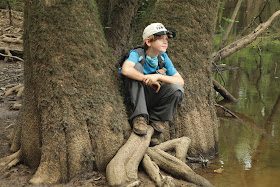About three hours east of
Greenville lies the small town of Mars Bluff. Originally known as Marr's Bluff
during the American Revolution, the name was shortened to Mars Bluff at some
point before the Civil War, near the end of which the inland Confederate Mars
Bluff Naval Yard was established.
I had never heard of the naval
yard, but the town’s name is familiar; Mars Bluff has the distinction of having
been inadvertently bombed with an atomic bomb by the United States Air Force.
This might otherwise not have been on my radar, but my boys are budding US history
buffs and so it was a given that we would eventually visit the site.
On a spring day in 1958, a B-47
Stratojet was en route to the U.K. to take part in “Operation Snow Flurry.” A
fault light lit up, indicating the bomb’s harness locking pin had not engaged,
and Captain Bruce Kulka went to investigate. As he reached around the bomb to
pull himself up he accidentally hit the emergency release pin; the 8,500-lb.
device hit the bomb bay doors, broke through them, and went screaming towards
earth.
 |
| Aerial photo of the Gregg home after the bomb (Photo credit: Columbia Star) |
Luckily for Walter Gregg and
his family, the bomb wasn’t armed with its nuclear rod; its fission core was
stored in a separate part of the plane. Unluckily for Walter Gregg, it was
loaded with about 7,600 pounds of explosives; the resulting explosion destroyed his house, flattened his garden & surrounding forest, and created a
mushroom cloud that could be seen for miles. By some miracle, not a single
person was killed in the blast. The military reimbursed Gregg giving him a chance to start over, and
the property was passed through the hands of several owners over the next fifty years. The hole was
never filled in.
The original bomb crater was 30
feet deep and measured 75 feet across, although today not much remains to
indicate that this was the site of a local footnote in Cold War
history. A historical road marker on the north side of Interstate 76 marks the
entrance to an overgrown road that leads to a hard-to-follow trail. Wind your
way through a pine thicket past the foundation of the Gregg house, and you’ll
come to what is now just a leafy depression in the woods, most easily recognized
by the large plywood cutout of a bomb and kiosk with newspaper stories that
were prepared for a 50th anniversary event. At one point the crater was used as
a burn pit, giving the rainwater a murky appearance.
 |
| Crater Road |
Because the property remains in
private hands, visitors need the owner’s permission to visit the site. There is
a second, much easier access point off Lucius Circle – also on private
property. To round out the trip, make sure to stop by the Florence County Museum after stops at the crater and historical
marker;
After the Mars Bluff incident
all flights were required to ensure that bombs were locked down properly before
takeoff. That still wasn’t enough to prevent a second Carolina event, as on January
23, 1961, a B-52 bomber broke up mid air, dropping two Mark 39 hydrogen bombs
over Goldsboro, North Carolina. Information declassified in 2013 showed that
one of the bombs came very close to detonating; it had its trigger mechanisms
engage and its parachute open, two things that only happen when the bomb is
intended to explode on target. Only one low-voltage trigger kept the bomb from
detonating upon landing. In July 2012, the State of North Carolina erected a
historical road marker in the town of Eureka, 3 miles north of the crash site,
commemorating the crash under the title "Nuclear Mishap" – maybe a
future destination for our crew?
 |
| "Commander Admits Crew Error Possible" and "It Was a Bad Day in Mars Bluff" |


















